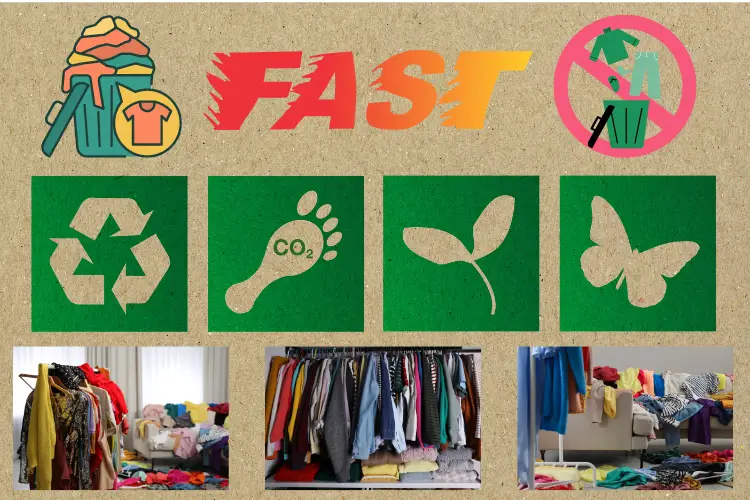Fast fashion has become synonymous with trendy styles and affordable prices. However, this convenience comes with a hidden cost: a significant environmental impact that ripples across the planet. Fast fashion refers to the rapid production of low-cost clothing, allowing consumers to frequently update their wardrobes with the latest trends. This model relies heavily on resource-intensive processes that pollute our air and water, deplete natural resources, and contribute to a growing mountain of textile waste.
The allure of fast fashion lies in its ability to quickly deliver new styles at a fraction of the cost of traditional fashion. Consumers are drawn to the idea of being able to wear the latest trends without breaking the bank. But this cycle of rapid production and disposal is far from sustainable. The environmental footprint of fast fashion is staggering, with the industry responsible for a significant portion of global pollution and waste.
Environmental Impact of Fast Fashion
Addressing these environmental concerns is crucial to ensure a sustainable future for our planet and the fashion industry itself. By understanding the true cost of fast fashion, we can begin to make more informed choices and support practices that prioritize environmental and social well-being. The journey towards a more sustainable fashion industry starts with awareness and collective action from consumers, brands, and policymakers alike.
Resource Depletion
The production of fast fashion garments consumes vast amounts of resources, placing a significant strain on the environment.
- Water: Producing a single cotton t-shirt can require up to 700 gallons of water. This staggering amount of water usage contributes to the depletion of freshwater resources, particularly in regions already facing water scarcity. For instance, the Aral Sea in Central Asia has shrunk dramatically in part due to water diverted for cotton farming, leading to severe ecological and economic consequences.
- Land: Cotton production, a major component of fast fashion, is extremely resource-intensive. Cotton is a thirsty crop, consuming large amounts of water and often leading to land degradation. Soil erosion and nutrient depletion are common issues associated with intensive cotton farming. Furthermore, the expansion of cotton fields can result in deforestation, which destroys natural habitats and reduces biodiversity. The conversion of forests to agricultural land not only contributes to habitat loss but also to increased carbon emissions, exacerbating climate change.
- Energy: The fast fashion industry relies heavily on energy throughout its supply chain. From the energy needed to produce raw materials like cotton and polyester, to the electricity used in factories, and the fuel required for transportation, the cumulative energy consumption is immense. This reliance on fossil fuels not only depletes natural resources but also contributes to greenhouse gas emissions.
- Materials: Synthetic fibers such as polyester are derived from petroleum, a non-renewable resource. The extraction and processing of petroleum for textile production deplete finite fossil fuel reserves and contribute to environmental pollution. Additionally, the production of synthetic fibers is energy-intensive and releases significant amounts of greenhouse gases.
Pollution
Textile manufacturing processes are a major source of pollution, affecting both the environment and human health.
- Air Pollution: Factories that produce fast fashion garments release harmful emissions into the atmosphere. These emissions include nitrogen oxides, sulfur dioxide, and particulate matter. These pollutants contribute to smog and poor air quality, leading to respiratory problems and other health issues in nearby communities. For example, cities with dense concentrations of textile factories often report higher rates of asthma and other respiratory conditions among residents.
- Water Pollution: The dyeing and finishing processes in textile manufacturing discharge a variety of harmful chemicals into water bodies. These chemicals include heavy metals like lead, mercury, and chromium, as well as toxic dyes and solvents. When released untreated into rivers and streams, they contaminate water sources, harming aquatic life and posing serious health risks to humans. The Citarum River in Indonesia, one of the most polluted rivers in the world, is heavily impacted by waste from textile factories, leading to severe ecological damage and health problems for local populations.
- Chemical Pollution: Many of the chemicals used in textile production, such as formaldehyde, chlorine, and volatile organic compounds (VOCs), are hazardous. These chemicals can leach into the environment during manufacturing and through the disposal of clothing. They contaminate soil and water, and can accumulate in the food chain, posing long-term health risks to both wildlife and humans.
- Microplastic Pollution: Synthetic fabrics commonly used in fast fashion, like polyester, nylon, and acrylic, shed microplastic fibers during washing. These tiny plastic particles are not captured by wastewater treatment plants and end up in oceans and other water bodies. Marine life, including fish and shellfish, ingest these microplastics, which can cause physical harm and introduce toxic substances into the food chain. Eventually, these microplastics can make their way back to humans, posing potential health risks.
- Waste Management Issues: Textile production generates a significant amount of solid waste, including fabric scraps, defective products, and packaging materials. Improper disposal of this waste can lead to soil and water contamination. Additionally, the incineration of textile waste releases harmful pollutants into the air, further contributing to air quality issues.
Waste Generation
The fast fashion model encourages frequent purchases and quick disposal, leading to an alarming amount of textile waste.
- Landfill Overflow: The rapid turnover of clothing in fast fashion results in mountains of discarded garments ending up in landfills. It is estimated that the average American throws away around 80 pounds of clothing each year. Globally, 92 million tons of textile waste are generated annually. Most of these clothes are made from synthetic fibers, which can take hundreds of years to decompose. As they break down, they release methane, a potent greenhouse gas that contributes to climate change.
- Incineration: Many discarded garments are incinerated to reduce the volume of waste. While incineration can generate energy, it also releases toxic chemicals and greenhouse gases into the atmosphere. Burning synthetic fabrics like polyester produces harmful substances such as dioxins and furans, which pose significant health risks to humans and animals.
- Microplastics: Synthetic fabrics, such as polyester, acrylic, and nylon, shed microplastic fibers every time they are washed. These tiny fibers pass through wastewater treatment plants and end up in rivers, lakes, and oceans. Microplastics are ingested by marine life, leading to physical harm and chemical contamination. This pollution not only affects aquatic ecosystems but also poses risks to human health when these microplastics enter the food chain.
- Unwanted Donations: Many people donate their unwanted clothes to charities, but the sheer volume often exceeds the demand. A significant portion of donated clothing ends up being shipped to developing countries, where it can undermine local textile industries. Moreover, much of it still ends up in landfills in these countries, contributing to their waste management problems.
- Short Lifespan of Fast Fashion: Fast fashion garments are often poorly made and designed to be worn only a few times before they fall apart or go out of style. This short lifespan exacerbates the problem of textile waste, as consumers frequently buy new clothes to replace the old ones. This cycle of constant consumption and disposal creates a continuous stream of waste.
Social Implications
The environmental impact of fast fashion extends beyond the planet, significantly affecting human health and well-being.
- Community Health: The pollution caused by fast fashion factories has detrimental effects on the health of surrounding communities. Air pollution from factories can lead to respiratory illnesses such as asthma, bronchitis, and even lung cancer. For example, residents near garment factories in countries like Bangladesh and China often suffer from poor air quality. Water pollution from toxic chemicals used in textile processing contaminates local water supplies, leading to waterborne diseases and other health issues.
- Labor Exploitation: Fast fashion’s focus on low production costs often comes at the expense of workers. Garment workers in developing countries frequently endure poor working conditions, low wages, and long hours. Many factories, sometimes referred to as sweatshops, ignore basic labor rights and safety standards. The tragic collapse of the Rana Plaza factory in Bangladesh in 2013, which killed over 1,100 workers, highlighted the severe exploitation and unsafe conditions in the garment industry.
- Economic Impact on Local Communities: The influx of cheap, fast fashion goods can undermine local textile industries, particularly in developing countries. When second-hand clothes are donated in large quantities to these regions, it can flood the market, making it difficult for local businesses to compete. This can lead to job losses and economic instability, further exacerbating poverty in these areas.
- Gender Inequality: The garment industry employs a large number of women, many of whom are vulnerable to exploitation. Female workers often face gender discrimination, earning less than their male counterparts and having fewer opportunities for advancement. Additionally, they may experience harassment and abuse in the workplace. Efforts to improve labor conditions in the fashion industry must also address these gender-specific issues.
- Child Labor: In some regions, the fast fashion industry relies on child labor to keep production costs low. Children working in garment factories are often deprived of education and a safe, healthy environment. They are exposed to hazardous working conditions, which can lead to severe physical and psychological harm.
- Consumer Health: The use of harmful chemicals in textile production not only affects factory workers but also consumers. Residual chemicals in clothing can cause skin irritation and allergic reactions. Moreover, the presence of toxic substances like formaldehyde and azo dyes in fabrics poses long-term health risks to wearers.
Sustainability Efforts
Despite the challenges posed by fast fashion, there are encouraging signs of change within the industry. Various sustainability efforts are being implemented to mitigate the environmental and social impacts of fashion.
- Sustainability Initiatives: Some fast fashion brands are adopting eco-friendly practices to reduce their environmental footprint. For instance, H&M’s Conscious Collection uses organic cotton and recycled materials, while Zara has committed to using 100% sustainable fabrics by 2025. These initiatives aim to lower water and energy consumption, reduce chemical use, and minimize waste.
- Recycled Materials: Many brands are incorporating recycled materials into their products. Recycled polyester, made from plastic bottles, is one example. This not only diverts plastic waste from landfills and oceans but also reduces the demand for virgin materials. Brands like Patagonia and Adidas have pioneered the use of recycled materials in their clothing and footwear lines.
- Reducing Water Usage: Some companies are investing in technologies to reduce water consumption in their manufacturing processes. For example, Levi’s Water<Less™ initiative has saved over 3 billion liters of water by altering the way jeans are made. Techniques such as dry dyeing and water recycling systems help conserve this vital resource.
- Supply Chain Transparency: Increasing transparency in the supply chain is crucial for ensuring ethical practices. Brands are now providing more information about their manufacturing processes and sourcing. For example, Everlane’s “Radical Transparency” campaign gives consumers detailed information about the costs and environmental impacts of their products. This transparency allows consumers to make more informed choices and hold brands accountable.
- Circular Economy: The shift towards a circular economy in fashion promotes the idea of keeping clothing in use for as long as possible. This includes clothing rental services, repair and alteration options, and recycling programs. Companies like Rent the Runway and ThredUp offer rental and resale services, making it easier for consumers to participate in a circular fashion model. Additionally, brands such as Eileen Fisher and Patagonia offer repair services to extend the life of their products.
- Innovative Fabrics: The development of sustainable fabrics is also making a difference. Materials like Tencel, made from sustainably sourced wood pulp, and Piñatex, made from pineapple leaf fibers, are environmentally friendly alternatives to conventional fabrics. These innovative materials have lower environmental impacts and offer biodegradable options to reduce waste.
- Certifications and Standards: Various certifications and standards help ensure that fashion products meet specific environmental and social criteria. The Global Organic Textile Standard (GOTS) certifies organic textiles, while the Fair Trade Certified™ label ensures that products are made under fair labor conditions. These certifications provide consumers with trusted options for sustainable and ethical fashion.
Consumer Awareness
Informed consumer choices are key to driving change in the fast fashion industry. By becoming more aware of the environmental and social impacts of their purchases, consumers can make a significant difference.
- Researching Brands: One of the first steps consumers can take is to research brands before making a purchase. Look for brands committed to sustainability and ethical practices. Websites like Good On You provide ratings and information on how brands perform in terms of their environmental impact, labor conditions, and animal welfare. Supporting companies that prioritize sustainability sends a strong message to the industry about consumer values.
- Quality over Quantity: Investing in well-made, durable clothing that lasts longer can reduce the frequency of purchases and the amount of clothing that ends up in landfills. High-quality items may have a higher upfront cost, but they offer better value over time. By choosing timeless styles and versatile pieces, consumers can build a wardrobe that is both sustainable and fashionable.
- Extending Garment Life: Proper care, repairs, and alterations can significantly extend the lifespan of clothing. Simple practices like washing clothes in cold water, air drying instead of using a dryer, and following care labels can prevent wear and tear. Learning basic sewing skills to mend small damages can also keep garments in use longer. Additionally, many communities offer clothing repair workshops and events that promote sustainable fashion practices.
- Embrace Second-hand: Exploring vintage stores, thrift shops, and online platforms for second-hand clothing is an excellent way to find unique and sustainable fashion options. Buying second-hand reduces the demand for new clothing and keeps existing garments in circulation. Platforms like Depop, Poshmark, and local consignment stores offer a wide range of pre-loved fashion items.
- Participate in Clothing Swaps: Clothing swaps are a fun and eco-friendly way to refresh your wardrobe. By exchanging clothes with friends, family, or through organized events, you can acquire new-to-you items without the environmental cost of new production. This practice promotes a sense of community and sustainable living.
- Support Sustainable Fashion Movements: Joining or supporting movements that advocate for sustainable fashion can amplify the impact of individual actions. Campaigns like Fashion Revolution encourage transparency in the fashion industry and advocate for fair labor practices. Engaging with these movements through social media, events, and petitions can help push for broader systemic change.
- Educate Yourself and Others: Staying informed about the issues related to fast fashion and sharing this knowledge with others can spread awareness and inspire collective action. Books, documentaries, and articles on sustainable fashion provide valuable insights. Encouraging conversations about sustainable fashion within your community can foster a culture of conscious consumption.
Conclusion
The environmental cost of fast fashion is undeniable. From resource depletion and pollution to overflowing landfills and human health risks, the industry’s current practices are unsustainable. The rapid production cycles and low-cost garments come with a hidden price that affects our planet and its inhabitants.
However, there’s hope for change. The growing emphasis on sustainability within the fashion industry, the rise of the circular economy, and increasing consumer awareness are paving the way for a more responsible fashion future. By supporting brands that prioritize ethical and eco-friendly practices, investing in quality over quantity, and embracing second-hand options, consumers can play a crucial role in this transformation.
The journey towards a sustainable fashion industry requires collective action from brands, policymakers, and consumers alike. By making informed choices and advocating for change, we can help reduce the environmental impact of fast fashion and ensure a healthier, more sustainable future for generations to come.



